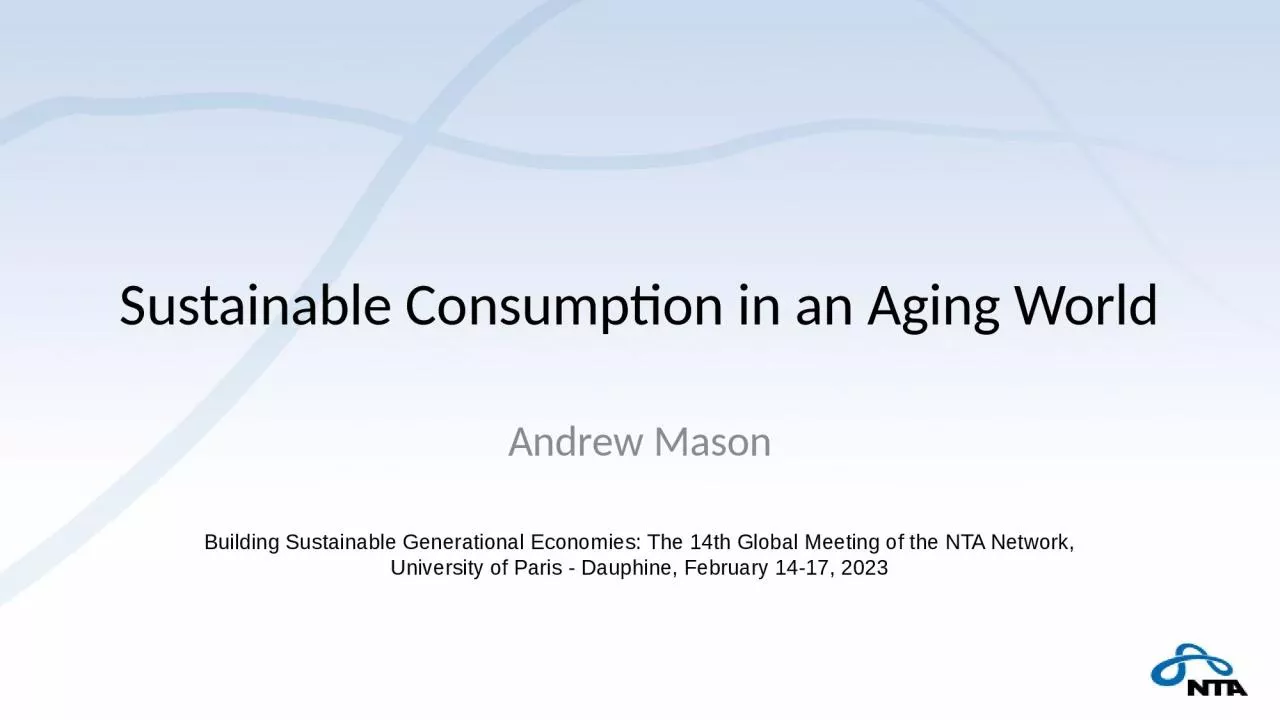

Andrew Mason Building Sustainable Generational Economies The 14th Global Meeting of the NTA Network University of Paris Dauphine February 1417 2023 Reform pensions More than ever we need to remind our Members of Congress that Americans 50 voted them into the very seats they occupy to ID: 1033703
Download Presentation The PPT/PDF document "Sustainable Consumption in an Aging Worl..." is the property of its rightful owner. Permission is granted to download and print the materials on this web site for personal, non-commercial use only, and to display it on your personal computer provided you do not modify the materials and that you retain all copyright notices contained in the materials. By downloading content from our website, you accept the terms of this agreement.
1. Sustainable Consumption in an Aging WorldAndrew MasonBuilding Sustainable Generational Economies: The 14th Global Meeting of the NTA Network, University of Paris - Dauphine, February 14-17, 2023
2. Reform pensions?“More than ever, we need to remind our Members of Congress that Americans 50+ voted them into the very seats they occupy today. The AARP community is nearly 38 million strong, our voices are powerful, and we don’t back down from a fight — especially when it comes to saving Social Security.” - AARP (American Association for Retired People)Email message from AARP advocacy on Jan 21, 2023.
3. Work longer?On January 19, 2023 over 1 million French protest against raising the retirement age from 62 to 64. Place de la Republique, Paris (AP photo/Lewis Joly)
4. IntroductionTwo issues Are current levels of consumption sustainable in light of population aging around the world? What policies might be pursued to increase sustainable consumption? Method for addressing the issuesNTA data on consumption and labor incomeDemographic data from UN World Population ProspectsSimulation model
5. Model FeaturesSteady state analysis that emphasizes the long-run and deemphasizes dynamicsFertility and mortality are exogenous; no immigrationReallocations systems are different for children and seniorsInterest rates respond to changes in population growth Consumption profile shifts to achieve sustainabilitySustainability is assessed using the lifecycle profile of wealth
6. Sustainable wealth profile for JapanSurvival weighted per capita longitudinal valuesBased on work by Lee and by Willis. Wealth consists of assets plus transfer wealth. Lee and Mason, Population Aging and the Generational Economy; UN NTA Manual.
7. Sustainable wealth profile for JapanSurvival weighted per capita longitudinal values
8. Solving for consumption level to achieve sustainable lifecycle wealthFinal wealth is zeroInitial wealth is zeroDiscount rate is biological rateDiscount rate is weighted average of biological rate and market rateAge of shift in lifecycle phases is endogenous Biological rate is rate of population growth plus rate of productivity growth (Samuelson 1958.)
9. Illustration of Model: Application to JapanFollowing questions are addressed: Is current level of consumption sustainable?How will sustainable consumption be affected byIncrease in life expectancy?Increase in fertility?Greater reliance on funded program rather than transfers to support old-age needs
10. Application to Japan Assumptions for baseline calculationsExogenous factorsJapan Baseline valueSourceConstant TFR1.29WPP estimate for 2019Constant population growth rate -1.6%Calculated from TFR with generation length of 30 years. Constant mortalitye0 = 85.6; e60 = 27.6 WPP Projections for 2025Child transfer share100%Used for all countriesOld-age transfer share49.8%Japan estimates from Lee and Mason 2018Consumption and labor income profilesSee figuresJapan NTA 2014 estimates from Ogawa and MatsukuraProductivity growth rates1.5%Used for all countries
11. Observed vs sustainable consumption, JapanSurvival weighted, per capita labor income for the cohort (based on 2014 NTA)Survival weighted, per capita consumption for a cohort (based on 2014 values)Sustainble survival weighted, per capita consumption is 79% of observed values.
12. Baseline vs sustainable consumption, JapanSurvival weighted, per capita labor income for the cohort (based on 2014 NTA)
13. Baseline vs sustainable consumption, JapanSurvival weighted, per capita consumption for cohort (based on 2014 NTA)
14. Baseline vs sustainable consumption, JapanSustainble survival weighted, per capita consumption is 79% of baseline values.
15. Affect on Sustainable Consumption of Longer life expectancyHigher fertilityGreater reliance on funded old-age reallocations?
16. Effects of higher life expectancy 2025 (e0 = 85.6; e60 = 27.6) vs 2065 (e0 = 90.4; e60 = 31.5) At older ages survival weighted consumption rises At most ages survival weighted consumption declines from 79% to 76% of baseline
17. Baseline consumption and sustainable consumption given TFRs of 1.29 or 1.75 Lower fertility: consumption 79% of baseline.Higher fertility: consumption 84% of baseline.
18. Baseline consumption and sustainable consumption given funded old-age reallocations: 49.8% or 66.7% shareWith increased emphasis on funded old-age reallocations, consumption would rise to 83% as compared with 79% of baseline.Higher share funded
19. Summary of application to JapanIs current level of consumption sustainable?No. Sustainable consumption is only 79% of current consumption.How will sustainable consumption be affected by:Increases in life expectancy?Projected increase over the next 40 years.Small effect on those below age 70. Survival-weighted consumption will be much higher for the very oldIncrease in fertility? Rise in TFR from 1.29 to 1.75Increase in sustainable consumption by 5 percentage points. Greater reliance on funded program rather than transfers to support old-age needs? Increase in funded share from about ½ to 2/3. Increase in sustainable consumption fy 4 percentage points.
20. QualificationsApplication is to Japan but the methods are general and can be readily applied to countries with NTA.Demographic change that leads to aging has favorable effects not addressed in this presentationValue of a longer life Improved reproductive health Second dividend effects (increases in human and physical capital)Reform often meets considerable resistance